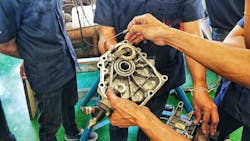Creating career technicians starts in schools, experts say
The industry's technician shortage has impacted nearly every fleet maintenance department, from dealerships to independent repair shops. Supporting vocational programs, ensuring they teach students the skills needed to develop into long-term technicians, and fostering strong mentorship programs to integrate new blood into the industry, are among the ways some leaders who spoke at the Fall 2022 HD Repair Forum are tackling the problem.
A panel presentation on the problem featured three industry experts: Brendon Eckenrode, the managing director of the Collision Repair Education Foundation (CREF), which supports educational programs for collision repair at a variety of student levels; Cindy Barlow, the director of industry outreach for WyoTech, a technical college for the automotive and diesel industry; and George Arrants, VP of the ASE Education Foundation, a nonprofit that trains and certifies auto and diesel technicians.
“Last year, we had about 2,200 accredited programs in the country. We make up about 40% to 45% of the total programs in this country, and we impacted over 126,000 students,” Arrants said. “[That] doesn’t sound like a shortage to me. Our biggest problem is, we have leaks in the pipe.”
See also: Three pillars to maintenance success
And why are there leaks in the pipe to begin with? “Because you as the industry are not in the local program,” Arrants asserted.
Eckenrode and Barlow agreed with Arrants' argument, outlining how each of their organizations—and the educational programs they work with—could use further support from the industry at large. Specifically, they also outlined how shops can support these much-needed schools, how schools and shops can create and find resilient techs when hiring, and how they can support new technicians as they transition into the workplace.
Supporting schools
According to Eckenrode, the CREF is contending with the closure of vocational programs, a factor that would exacerbate the technician shortage.
“We are hearing, unfortunately, that programs are constantly inadequate and basically put on the chopping block because of a lack of student enrollments, lack of books, or a lack of an administration that believes in our programs,” Eckenrode said. “So, we have a lot of calls, emails, and panic notes from instructors saying, ‘If I don’t get more students, my program’s going to be gone.’”
To protect against this potential rupture of the technician pipeline, CREF works in three key areas:
- Attract students to technical schools.
- Widely promote these programs.
- Support these programs once the students are enrolled.
Attracting industry help and promoting institutes often go hand in hand in making sure that the public neither perceives auto collision as a last-resort career, nor do the schools providing training look like a last resort, Eckenrode stresses.
See also: How shop culture plays a role in recruiting, retaining technicians
“We want to make sure that we’re a first choice to students as opposed to a leftover dumping ground like some of these programs are viewed as,” he explained.
This means asking for shops’ help, along with CREF's, in ensuring that the schools’ classrooms and training floors are properly renovated and stocked, and that students have uniforms and access to tools and vehicles with which to work. For CREF, this also means getting in front of middle-school and high-school counselors, ensuring that they know that commercial vehicle repair is a viable, profitable industry to steer interested students towards. Then, of course, there’s supporting the students once they’re already in their program—beyond showing up on their graduation day for hiring purposes.
“What instructors hate is when [prospective employers] show up in the spring, and have not been around the entire time, and say, ‘Give me your best students," Eckenrode insisted. “We want to help make sure that you get to go in and actually meet the students to motivate them to stay within the program and hopefully come into the industry.”
Being involved in education programs doesn’t need to be difficult, either. That can include providing speakers for student lectures, donating leftover materials, such as fenders and hoods, for the students to practice with, and joining advisory boards.
Encouraging resilient technicians
Although institutions can use all the physical help they can get, shops also can seek and encourage the soft skills that will give them a long-term technician in the shop, not just a quick hand who, even though they are technically knowledgeable, will leave within two years.
“You guys right now are hiring for those hard skills because you have an urgency to be able to get things turned back around,” Barlow said. But she added that soft skills also are integral to their sustained success.
See also: Fullbay to host first Diesel Connect conference in June
These soft skills include the many abilities one might take for granted in employees, including arriving on time, adaptability, conflict resolution, critical observation, teamwork, and problem-solving shops. Employers should seek out these skills to find the technicians who will best serve them in years to come, Barlow said.
In particular, adaptability is a critical trait to filter for when hiring a technician as the pace of development in vehicle repair only continues to accelerate.
“You want to be able to understand, as you're recruiting, and as we're teaching, how do [technicians] adjust for changes in your work environment?” Barlow said. “How flexible can they be with what they're working on, as they move from station A to station B?”
Cultivating such skills while hiring, secure in the knowledge that schools such as WyoTech are encouraging them as well, will lead to creating a workforce that’s not just well-trained, but well-adapted to the commercial repair industry.
Transitioning students into technicians
However, even if a shop hires a fresh student who came from a strong program that was both well-funded and instilled in them the resiliency to succeed, they still won’t get far if they aren’t fully incorporated into the workspace.
“They have training and knowledge but no experience; they’re getting it from you,” Arrants said. “You have to mentor these young people. You have to onboard them into your shop culture. If you just expect them to show up on the first day of work and be productive, God love you.”
According to Arrants, one of the first reasons for students veering away from technician training is a lack of a defined career path. Providing that career path means having a process for new technicians as they arrive and having a plan for their development beyond instant productivity. This kind of personalized support is what keeps technicians from leaving after two years of work, because they have a guardian, or a mentor, to help them through a period that otherwise might drive them away.
See also: Should your fleet contract out its maintenance?
“And selecting that mentor? What does that mean?” Arrants asked. “It’s not your best guy. It’s a guy who’s been in the business for four or five years, been with your company at least a year, somebody who likes working for you, and likes our industry.”
But shops don’t need to create a mentorship investment program on their own. There are programs and technologies meant to help develop young talent in a structured way that provides clarity to all involved, from the technician to their mentor to their manager.
Arrants described an app that ASE uses called Mentor Mentee. They use it for two apprenticeship programs, both of which allow a mentor to track their mentee’s proficiency for individual jobs. The app also provides assessments to make sure that everyone involved in the apprenticeship knows what’s expected of them and has the training they need to ensure success, as well as task lists to track each worker’s progress.
“You can grow that individual and give them pay based on how well they do a certain labor operation,” Arrants explained. “You also, as a manager, can see what the student is being exposed to on a day-to-day basis. You can also manage expectations with the instructor in the school. It's a full partnership, everybody working together to grow this workforce.”
About the Author
Alex Keenan
Alex Keenan has been associate editor for Endeavor's Commercial Vehicle Group, which includes FleetOwner magazine, since 2022. She has written on a variety of topics for the past several years and recently joined the transportation industry, reviewing content covering technician challenges and breaking industry news. She holds a bachelor's degree in English from Colorado State University in Fort Collins, Colorado.

